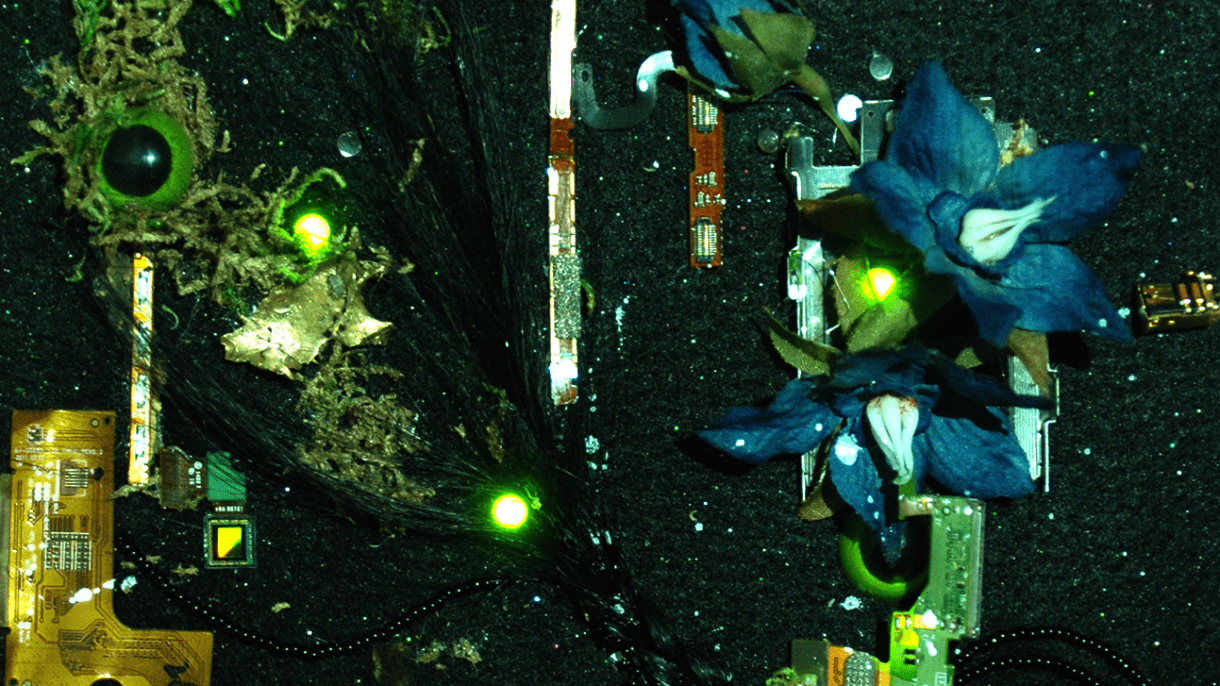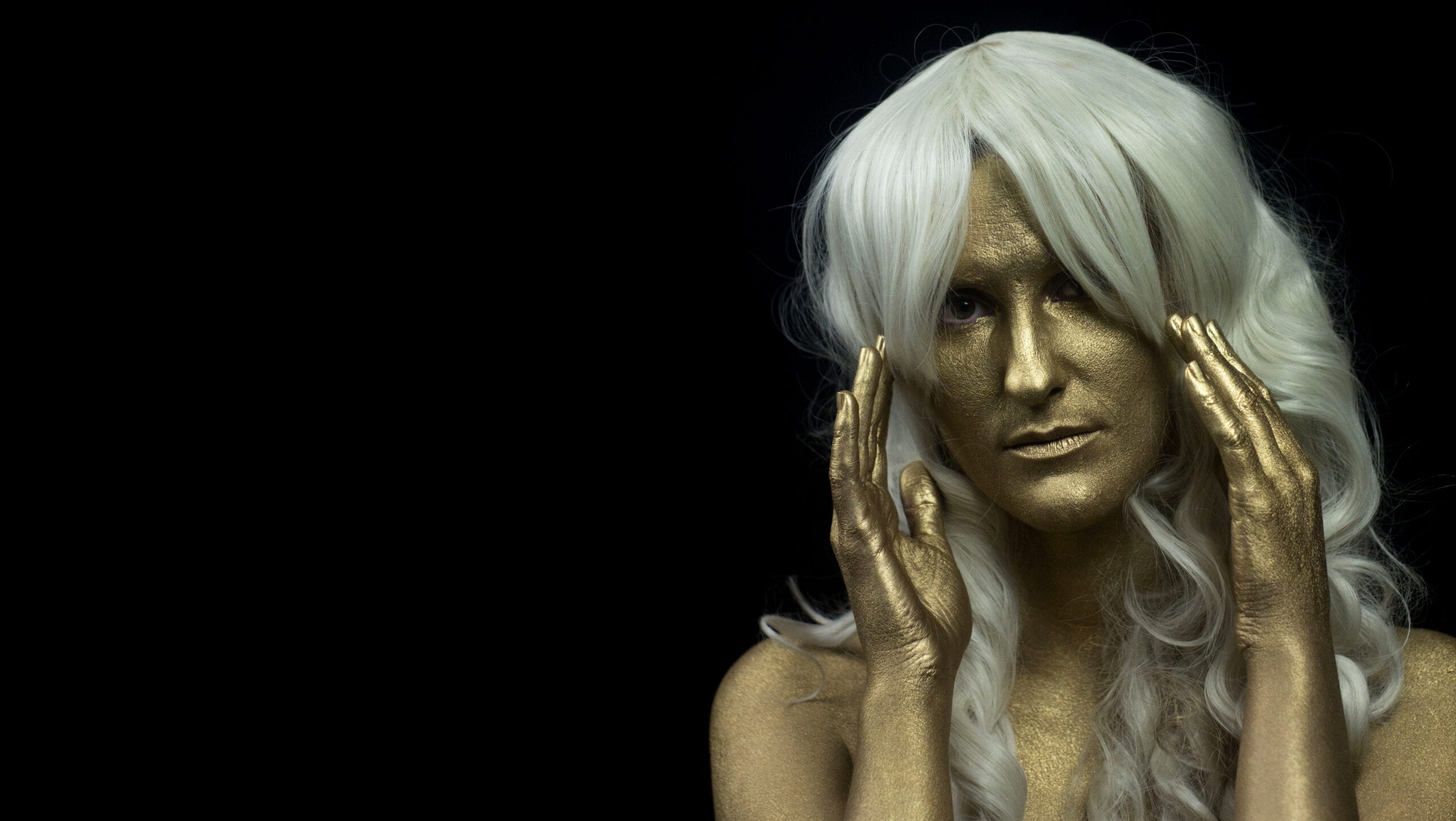Deep Space Nine took viewers on a voyage where no other Star Trek series had gone before. Starting with its hard-hitting series premiere in January 1993, the show initiated warp speed conversations on difficult topics. For Toronto-based electronic artist Laura Dickens (a.k.a. Leucrocuta), the socially-conscious sci-fi series was the inspiration for her upcoming album, Kentanna. As she explains, the issues covered by DS9 throughout its seven seasons included gender identity, queer sexuality, race, war and colonization, among many others. Sampling elements of the show—like distorted dialogue, chattering sound effects and the ambient hum of its space station—she creates wormholes of sound to suck listeners inside. Dickens was too young to watch DS9 during its first broadcast, but discovered its syndicated reruns in high school. She believes the show’s darker themes might have initially made it less popular than both the heroic storylines of Star Trek’s original series and first spinoff, The Next Generation, but have since turned DS9 into a cult favourite. As the first Trek show to include serialized storylines spanning entire seasons, DS9 was also equipped to dig deep into critical analysis and the intimate development of its characters. One apt example of the latter is Jadzia Dax, whose last name is the title of the opening song on Leucrocuta’s new album. As a member of the Trill species, Dax co-exists with a sentient, symbiotic organism that moves between host bodies over hundreds of years. When viewers meet her in the series premiere, she has left the body of an elderly man and reemerged as a younger woman. As a synthesis of every being she has inhabited, Dax contains the memories, personalities and skills of her previous hosts. This provided DS9 with an allegory for gender transition, as well as the chance to air one of the earliest televised lesbian kisses. “When you’re a queer person, you can’t necessarily look to your family’s history for a sense of self,” Dickens says. “You grow up, get older and learn more about yourself, but might not have models in your parents or teachers. Gradually, as you learn more about history, it’s like feelings you find in a similar way to the character Jadzia Dax. She has memories of past lives that come up throughout the series, including a relationship with a woman.” Dickens also highlights how the series challenged notions of diplomacy and intervention. Its overarching plot follows the United Federation of Planets (a union of governments guiding the actions of the space station Deep Space Nine) as they attempt to aid in the rebuilding of Bajor, a planet newly freed from the brutal occupation of the Cardassians. This creates friction between the Bajoran people and the Federation, who believe the efforts of a provisional government will only result in assimilation. “The original Star Trek series presented a future of humanity where we’ve solved all of these problems,” says Dickens. “People of different races and ethnicities are working together, there’s no money and everybody has a purpose in their own lives. I think a lot of the ideas behind that are like a very liberal utopia, where we can all absorb differences. DS9 says sometimes that doesn’t work and it fails.” Dickens’ romantic and creative partner, Dot Starkey (a.k.a. Hex-A-Decimal), provides her with several levels of support. Along with collaborating on writing and joining Dickens in a duo version of Leucrocuta for live performances, Starkey is set to release her partner’s new album on her label, Lost Angles. Since its formation in 2015, Starkey has created an international nexus for electronic artists, dubbing their music onto limited runs of cassettes, records, VHS tapes and floppy disks. Though primarily focused on vaporwave—a sub-genre of electronic music that repurposes cultural artifacts from 1980s and ’90s—Lost Angles’ releases have included everything from synth-pop and dark ambient, to songs made from samples of George Costanza speaking. As a trans woman and a fellow Trekkie, Starkey has felt her own experiences reflected in the gender-focused episodes of DS9. She notes that the series was able to tackle contemporary issues due to the fact that Star Trek creator Gene Roddenberry had passed away before it debuted. While previous series avoided any discussion of religion or spirituality, DS9 fearlessly approaches them in the same way Captain Sisko sends his Starfleet into battle. “I think DS9 was very successful in talking about how not everyone gets to be the hero all the time,” says Starkey. “Heroic characters get to regain the status quo in the other series. [But] because DS9 was serialized and took place in this one specific location, it showed how people couldn’t just escape these problems by moving on to a different galaxy. They had to consistently revisit those problems and deal with them.”

The cover art for “Kentanna” is by Sheri Osden Nault.
During a work study program at the Banff Centre, Dickens met Sheri Osden Nault, a non-binary visual artist of mixed Métis and European descent. The piece Nault created for Kentanna’s album cover imagines an alternate form of futurism where Indigenous people are unhindered by colonization. Leaning into Star Trek’s campy aesthetics and practical effects, they crafted a tactile version of the DS9 wormhole from materials such as fake flowers, plastic eyes, deconstructed cell phones, glass beads, moss and hair. Rather than using a digital program like Photoshop to alter the image, they chose to work in analog with LED lights and gel filters to create its neon colours. “It’s more of a metaphoric image than an outright representation of DS9’s setting,” says Nault. “I was imagining the points of organic and technological existence near the wormhole. The hair is braided and there is beadwork inspired by traditional practices. By bringing all of these elements together, I wanted to speak to the energy that infuses life. It isn’t absent from space or technology, but rather connects all of those forms of being.” Nault points to another moment in DS9’s premiere episode that strongly resonates with real life. When the Federation’s doctor Julian Bashir first appears, he ecstatically shares his enthusiasm to practice “real frontier medicine” in the “wilderness” of the planet Bajor. Major Kira, a Bajoran militia officer assigned to Deep Space Nine, righteously responds to him: “That wilderness is my home!” As Nault explains, this tension continues into the present day in any country founded on treaties between colonizers and Indigenous nations that have yet to be honoured. “Unlike the Bajorans, the Indigenous peoples of North America are still living with our equivalent to a Cardassian occupation,” says Nault. “To take the analogy too far: Settlers, our Cardassians, think they’re the, presumably, well-intentioned and caring United Federation of Planets. “Unceded lands are still being invaded at gunpoint while communities developed through forced segregation don’t even have safe drinking water,” they say. “When you consider the malicious attitudes of too many Canadians towards Indigenous people, the lie in that ‘good guy’ persona that settlers think represents them really starts to show.” Apart from the upcoming release of her DS9-inspired album on September 25, Dickens remains prolific. July saw the arrival of another Leucrocuta long-player called How I Touched It Last on Kentron Records, the label run by fellow Toronto electronic artist Poster Boy. This collection of songs swerves into territories of avant-pop, as fractured beats collide with wobbly synth basslines and old school vocoder. On the album’s single, “Don’t Resist,” Dickens’ stone-faced spoken word vocals deliver a satirical ode to retail therapy (“Don’t resist, just buy it / Girl, you deserve it”) in the vein of Marie Davidson. In the near future, Leucrocuta will release yet another EP with an accompanying 3D video. And Starkey will perform at an upcoming edition of the live stream series “Frequencies,” while continuing to grow the extended family of Lost Angles. This fearlessly unique duo are exploring strange new worlds, boldly going where no one has gone before.


 Why you can trust Xtra
Why you can trust Xtra


